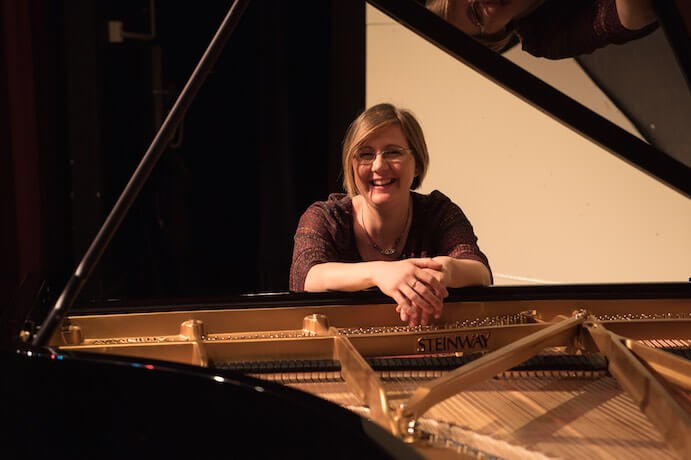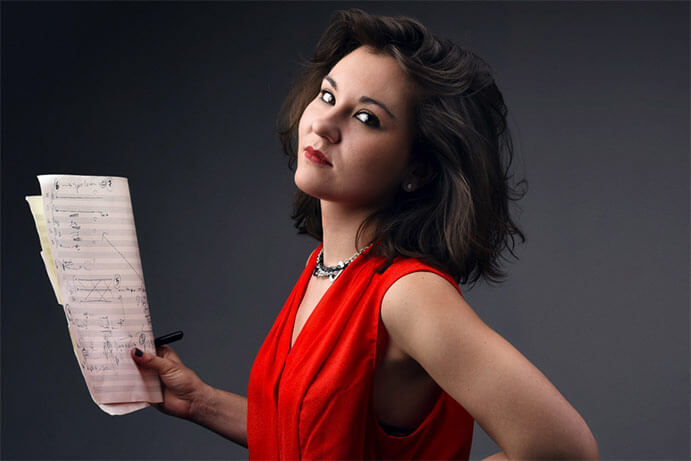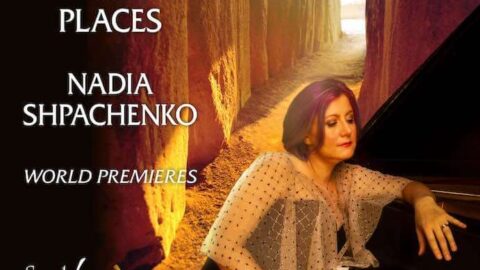Multi-GRAMMY nominated pianist Nadia Shpachenko reflects on the role of the concert hall in the liner notes for her recent Reference Recordings album The Poetry of Places: “The hall is the most important instrument…we spend a great deal of time learning to embrace the space, learning what our pieces mean in the space, how our interpretation must change because of where we are.” An album of solo and duo piano, electronics, and percussion, The Poetry of Places is a superb assemblage of works by various composers. Each piece, inspired by a particular building, weaves together a collage of place and time, and Shpachenko’s evocative interpretations bring insight to the composers’ visions in collaboration with pianist Joanne Pearce Martin and percussionists Nick Terry and Cory Hills.
Frank’s House by Andrew Norman features all of the performers in swirling vortexes of knells between piano and percussion, representing the jagged asymmetry of Frank Gehry’s home in Santa Monica. Shpachenko and Martin play a nostalgic waltz that wafts up amidst the clamor, only to be squelched by aggressive outbursts by Terry and Hills. Harold Meltzer’s In Full Sail for solo piano ties in a depiction of Gehry’s IAC building in New York City. Seeking to capture the sense of wave-like motion inherent to its architecture, Shpachenko delivers glorious moments of polyrhythm shimmering and gliding through space.

Jack Van Zandt’s Sí an Bhrú is confusing at best in its intentions of depicting a Neolithic structure built circa 3200 B.C.E. known as “Newgrange” in English. While the first movement contains gleaming electronics blending seamlessly with well-placed chords that highlight the natural overtones of the pitches, the third movement breaks the character of the piece by moving into transplanted mimicry of Pierre Boulez, followed by the fourth movement, “Dance of Renewal,” which cheaply incorporates a synthetic hi-hat against a slightly off-kilter groove in the piano. Sorely out of place, this movement comes across tone-deaf to depicting how these ancient civilizations may have lived and the majesty of such a building.
One of the highlights of The Poetry of Places is Hannah Lash’s Give me your Songs, a multifaceted illustration of Aaron Copland’s house. The songful fragments of material weave and intermingle with one another, creating a fabric that stitches together the cascading off-centered structure and winding pathways surrounding his home. Shpachenko sensitively approaches each attack with breathless understanding of music and place, transporting the listener to upstate New York and through the historic passageways of the house.

Another true standout of the album is Amy Beth Kirsten’s h.o.p.e., inspired by The Big Hope Show in 2015-16 at the American Visionary Art Museum in Baltimore. Focusing on the transformative power of hope and “super-survivors” in the midst of tragedy and trauma, Kirsten’s simple monophony on piano and toy piano ring with bittersweet poignancy. The moment Shpachenko sings in child-like naivety is pure magic, as the unison slowly breaks and unravels into unison once more, painting the rebirth of spirit and hope in subtle brilliance.
James Matheson’s Alone, in waters shimmering and dark consists of three short movements which depict a solitary house on an island in upstate New York. Matheson viewed the structure from afar as well as imagined how his perspective would change from inside the house looking out. The second movement, “Capillary Waves,” displays Shpachenko’s fierce appetite for the intricate, showcasing her technical prowess in a dance-like flood of notes. The last movement, “To Sky,” written in memoriam for Matheson’s late mentor, Steven Stucky, resonates in an introspective cavern of space, the two hands in opposite registers of the piano. In Matheson’s words, he stunningly captured “the fine line between loneliness and its happier sibling, solitude.”
Lewis Spratlan’s Bangladesh borders on pentatonicism as it moves from one section to another, depicting the buildings that comprise the National Assembly in Bangladesh. Situated on the water, Spratlan paints a liquid cascade of scales that rises and falls to depict the people of Bangladesh, the architect who conceived of the complex, and the builders who labored to bring the vision to fruition.

The final piece on The Poetry of Places is Nina C. Young’s Kolokol, a fantastical kaleidoscope of two pianos and electronics comprised of field recordings of the Danilov bells that hang in Cambridge, MA at Harvard. The bells clang in their original brilliance in the electronics and also create synthetic piano sounds in tunings that do not exist on the piano, creating a trio of sorts, a true Klangfarbenmelodie through the colors of the bells and pianos that seamlessly intermingle with one another.
Through the entire album, Shpachenko’s dedication to each work is abundantly clear. Her clean, crisp attacks ring delicious in the ear while the lush garden of warm rumblings evoke the imagination to far off places and civilizations. Her supporting cast of composers and performers enrich The Poetry of Places‘ diversity and nuance, creating a focused, coherent narrative through which to travel.
























